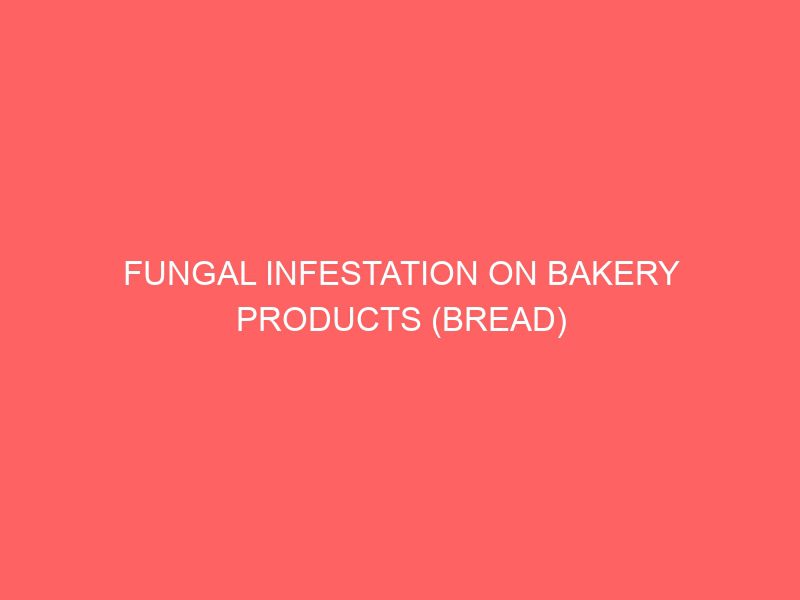Description
CHAPTER ONE
1.1 BACKGROUND INFORMATION
This research is on Fungal infestation on bakery products (bread). Bread is a staple food prepared from a dough of flour and water, usually by baking. Throughout recorded history it has been popular around the world and is one of the oldest artificial foods, having been of importance since the dawn of agriculture.
Proportions of types of flour and other ingredients vary widely, as do modes of preparation. As a result, types, shapes, sizes, and textures of breads differ around the world. Bread may be leavened by processes such as reliance on naturally occurring sourdough microbes, chemicals, industrially produced yeast, or High pressure aeration. Some bread is cooked before it can leaven, including for traditional or religious reasons. Non- cereal ingredients such as fruits, nuts and fats may be included. Commercial bread commonly contains additives to improve flavor, texture, color, shelf life, nutrition, and ease of manufacturing.
A fungus is any member of the group of eukaryotic organisms that includes microorganisms such as yeasts and molds, as well as the more familiar mushrooms . These organisms are classified as a kingdom , Fungi , which is separate from the other eukaryotic life kingdoms of plants and animals.
Fungi are the principal decomposers in ecological systems. These and other differences place fungi in a single group of related organisms, named the Eumycota (true fungi or Eumycetes ), which share a common ancestor (form a monophyletic group), an interpretation that is also strongly supported by molecular phylogenetics . This fungal group is distinct from the structurally similar mycomycetes (slime molds) and oomycetes (water molds). The discipline of biology devoted to the study of fungi is known as mycology (from the Greek mykes, mushroom). In the past, mycology was regarded as a branch of botany, although it is now known fungi are genetically more closely related to animals than to plants. Abundant worldwide, most fungi are inconspicuous because of the small size of their structures, and their cryptic lifestyles in soil or on dead matter. Fungi include symbionts of plants, animals, or other fungi and also parasites. They may become noticeable when fruiting , either as mushrooms or as molds. Fungi perform an essential role in the decomposition of organic matter and have fundamental roles in nutrient cycling and exchange in the environment. They have long been used as a direct source of human food, in the form of mushrooms and truffles; as a leavening agent for bread; and in the fermentation of various food products, such as wine , beer , and soy sauce . Fungi have been used for the production of antibiotics , and, more recently, various enzymes produced by fungi are used industrially and in detergents . Fungi are also used as biological pesticides to control weeds, plant diseases and insect pests. Many species produce bioactive compounds called mycotoxins , such as alkaloids and polyketides, that are toxic to animals including humans. The fruiting structures of a few species contain psychotropic compounds and are consumed recreationally or in traditional spiritual ceremonies.Fungi can break down manufactured materials and buildings, and become significant pathogens of humans and other animals. Losses of crops due to fungal diseases (e.g., rice blast disease) or food spoilage can have a large impact on human food supplies and local economies.
The fungus kingdom encompasses an enormous diversity of taxa with varied ecologies, life cycle strategies, and morphologies ranging from unicellular aquatic chytrids to large mushrooms. However, little is known of the true biodiversity of Kingdom Fungi, which has been estimated at 2.2 million to 3.8 million species. Of these, only about 120,000 have been described, with over 8,000 species known to be detrimental to plants and at least 300 that can be pathogenic to humans. Ever since the pioneering 18th and 19th century taxonomical works of Carl Linnaeus , Christian Hendrik Persoon hand Elias Magnus Fries, fungi have been classified according to their morphology (e.g., characteristics such as spore color or microscopic features) or physiology. Advances in molecular genetics have opened the way for DNA analysis to be incorporated into taxonomy, which has sometimes challenged the historical groupings based on morphology and other traits. Phylogenetic studies published in the last decade have helped reshape the classification within Kingdom Fungi, which is divided into one subkingdom , seven phyla, and ten subphyla.
The concept of food infestation of fungal organisms is based on the consipteration for fiutres of consumption. Infestation is defined as the over presence alone has led to its growth and microbial activity. Pathogenic organisms however can cause food poisoning. Food poisoning can arise through infatuation of food by organisms (micro) which secrete toxins which B their consumed. The cost of fungal infested bread resulting to spoilage is also great with loss of money due to wastage of the raw materials. Also considering the usefulness of this product in the community with the management of money being spent it has also helped in the sense that since it is regarded as a fast food it is being bought and consumed directly without further preparations done. Effect of contaminated bread in the society can lead to an epidemic of gastrointestinal disorder where by that particular environment that consumed the contaminate bread become affected there by developing stomach upset.
Mouldiness is one of the most common microbiological defects, found in bakery industry. It is estimated that approximately 1-5% of the bread production goes wrong due to fungi activity. Refering to bread, mold contamination determines not only changes in color, taste, but also loss of the food quality as a result of possible formation of mycotoxins. Mouldiness is caused by external contamination of bread after baking, because the existing spores in flour during a normal technological process don’t have any multiplication conditions, and during baking they are destroyed. Bread contamination with molds, may occur in the following steps: the transportation of bread; during cooling and storage; while cutting and packing (optional operation). Propagation of mold spores and contamination of bread can take place indirectly by air in the storage room (the air) or by direct contact with boxes, crates, hauling equipment etc. Among the molds that frequently contaminate bread during storage, there are the following common species and genera: Alternaria, Aspergillus, Cladosporium, Geotrichum candidum, Mucor, Neuropspora sitophila, Penicillium, Rhizopus stolonifera, Thamnidium elegans. By the development of other fungi superficial pigmentation are produced, which only affects the commercial appearance of bread. Under these/ the given circumstances, the development of Geotrichum auranticum and Thamnidium auranticum, gives a red- gold coloring of the bread in the colonies’ development surface.
The type of mold the grows on bread is Rhizopus and penicillium. Preservatives used on bread to increase it duration are sulfur dioxide and Lechithin.Sulfur Dioxide is use to increase its shelf life and Lechithin is used to increased the time a bread is fresh. The purpose of this experiment is to see in which of the 3 enviroment does mold grow the most. Mold growing on the bread can be microscopic fungi belonging to different species like Penicillium, Rhizopus, Aspergillus, Monascus and Fusarium. They are of different shapes and colors depending on the species. Rhizopus stolonifer is the most common and fast growing bread mold. It is also known as black mold as it appears dark green or black in color. It causes rotting of some fruits and some infections in humans.
Microscopic parts of the bread mold fungi, known as spores, are present in the air all around us. They can be found on any surface and in any condition. They appear on the surface of bread that may be left open in normal conditions, say on the kitchen countertop. These spores germinate to form hyphae that begin to grow on the bread surface absorbing all the moisture and nutrients from the bread. With adequate nutrients from the bread they develop into mature fungi that consists of rhizoids. These rhizoids penetrate into the bread surface and hold the fungus to the organic material. It then develops fruiting structures known as sporangium, where small spores grow and are released in the surrounding areas.
Bread mold growth rate depends on several factors, temperature being the most important one. The growth rate of mildew would be slowed down, especially if the bread is kept in the refrigerator. It is observed that most molds thrive in temperatures above 70ø F, and the low temperatures in the refrigerator are unfavorable for bread mold. Putting the bread slice in the freezer will stop the growth of mold completely as the temperatures in the freezer are way below the favorable temperature. As bread mold is a living organism, it requires moisture and oxygen to grow. The moisture trapped in the bag is absorbed by the fungus and it grows at a faster rate. However, as mold is a type of fungi and not a plant, bread mold does not require light for its growth.
1.2 AIMS AND OBJECTIVES OF THE STUDY
This project is based on the isolation and identification of the fungi organism responsible for the spoilage of bread. To examine the species of fungi that infest bread at room temperature.
The objective of this work is to make a short review in respect to characterize the behaviour of some spoilage and pathogenic microorganisms and their impact in bakery products. The paper presents an inventory of microorganisms involved in spoilage and safety of bakery products.
1.3 HYPOTHESIS
H0- filamentous fungi and yeast has no effect on bread.
H1-filamentous fungi and yeast are responsible for spoilage of bread when infested.
If the growth of mold is affected by the environment then the dark place will be where most mold will grow. In this experiment, the independent variable was the amount of mold that grown on the bread
1.4 STATEMENT OF PROBLEM
Problems encountered by the society as a result of the consumption of contaminated bread infested with fungal organism art circulation in the market places are related health wise, in the sense that when contaminated. Breads are eaten; it leads to caster or intestinal disorder by some fungal organism which is an a result of deposited toxins. This can lead to an epidemic, when a batch of count ammoniated breading in circulation.
1.5 SIGNIFICANCE OF STUDY
The justification of this research study is to ensure that a well prepared baked bread devoid of fungal growth is being circulated on sold.
1.6 LIMITATION OF THE STUDY
This project work is limited to the isolation and identification of fungal organism present filamentous fungi and yeast. This is also limited restricted on the examination of the end product which is the baked bread and not its raw material which is the flour, practical works is car ied out on the pathogenically of species identified as this could be another area of study for interested microbiologists







